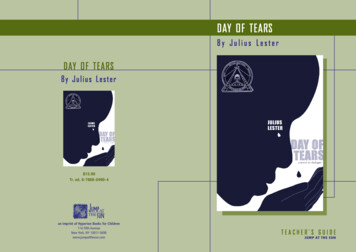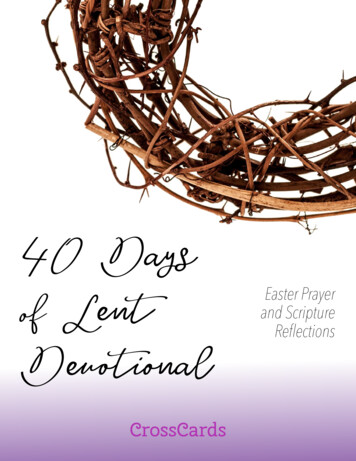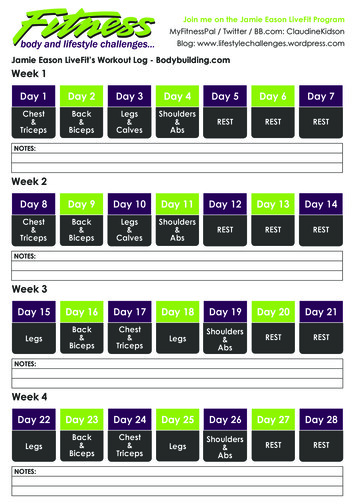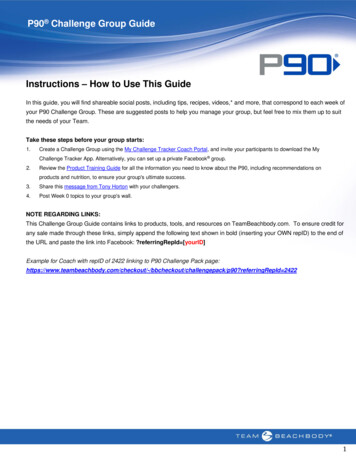
Transcription
DAY OF TEARSBy Julius LesterDAY OF TEARSBy Julius Les t e r 15.99Tr. ed. 0-7868-0490-4an imprint of Hyperion Books for Children114 Fifth AvenueNew York, NY 10011-5690www.jumpatthesun.comtea c h er ’ s G u i deJUMP AT THE SUN
Introd uctionIn Day of Tears, Julius Lester exposes the devastating reality of the slaveexperience. The novel begins with the largest slave auction in Americanhistory (later known as The Weeping Time). During the auction, membersof slave families are sold to different masters and must face the fact thatthey will never see each other again. Lester takes you into the minds of theslaves and masters as he follows a girl’s journey from slavery to a life offreedom.TABLE OF CONTENTSACTIVITIES2Comprehension check4Discussion QUESTIONSFOR SMALL GROUPS5an interview with JULIUS LESTER6for FURTHER READING9WEB SITES9
Readers’ TheaterA c t i v i t i esAsk students to choose different characters and read their sections aloud.Discuss how the students feel assuming these roles.Keep a reading journalHave the students write down everything they know about the slaveryof black people in America before reading the novel. Have them jotdown reactions, questions, and thoughts. Ask the students to revisit theirinitial list after completing the book. Has the book revealed anythingsurprising about slavery? Did the students have misconceptions thathave now changed?Writing exerciseImagine yourself as a slave. Write a monologue about your experience andfeelings. Feel free to imagine your own surroundings and circumstances.How do you get through each day? Do you have hope for freedom and abetter life?Role-PlayingResearch projectsHave two or three students work together to research a topic and give apresentation to the class. The students should create visual aids toaccompany their presentations. Organize all of the projects in the room,to create a museum. Invite parents, as well as other students in the school,to visit the museum.Possible topics The Weeping Time (create a mural; look at the historical documents) Economics of slavery The Underground Railroad (write a description of the history; create a3-D map in papier-mâché outlining the underground railroad and usingcraft materials for people, houses, boats, etc.) “Jumping the broom” wedding celebrations High John and Brer Rabbit (the history of the oral traditionamong black Americans) The Civil War (prepare a time line and/or a brief overview) The Emancipation Proclamation Canadian communities of former slaves Runaway-slave laws Enslaving Virginia (explore the reactions to a modern-day reenactmentin 1999 of a slave auction in Colonial Williamsburg)2Argue different points of view based on the personalities of the characterspresented in the novel. Here are some examples:Master ButlerWhy you feel you have no option but to sell your slavesMattieWhy you fear Emma’s attending the auctionEmmaYour fears about leaving your family and your hopes forfuture generationsFanny KembleWhy you left your husband, how you feel about slavery, and how you feelabout your husband’s latest actionsJeremiah HenryHow you feel about slavery and what part you can play in helping theslaves escape to the North3
Co m p re h ens i on C h e c kD i s c u ss i on Q u est i ons for s m all gro u p s *1.Describe the relationships between Mattie, Will, and Pierce Butler.2.Why does Pierce Butler sell his slaves?3.Why is Mattie worried about Emma’s going to the auction withthe Butler girls?4.Why does Fanny Kemble leave the plantation?5.How do Jeffrey and Dorcas get separated? What happens when Jeffreyfinds Dorcas years later?6.What does Emma say to Sarah when she leaves to go with hernew owner?7.Describe Sarah’s relationship with her father when he is on his deathbed.8.Why does Emma refuse to “jump the broom” with Joe in chapter 8?9.Who is Mr. Henry? How does he help Joe and Emma?1.Why do you think it was illegal to teach slaves? What impact did this haveon Emma’s views on education?2.How do you feel about Sampson’s character? What did you discoverabout Sampson’s true feelings toward slavery and about his relationshipto his son?3.Will says,“Master want to pretend like me and Mattie don’t havefeelings same as him.” Why do you think the slaves were treated as if theywere not capable of the same range of emotions as are whites?4.How did the attitudes of the older slaves differ from those of theyounger slaves?5.Blacks and whites in this novel use the word “nigger” to refer to blackpeople. How does this usage make you feel? What does it mean? Do youthink it is appropriate for people to use that word today?6.Were you surprised to learn the amount of racism blacks faced in theNorth? Write about the situation for blacks in the North based on thedetails provided in the novel. Were blacks equal to whites? How didthey support themselves? Why did they have to fear being “caught”again by a white person?7.Why did Julius Lester choose to write in the first person? How does thisformat affect the way the characters come across?8.Julius Lester also places interludes throughout the novel. What is aninterlude? How does it affect the way the story is told?10. How does Sampson feel about slavery? Does Sampson really stand in theway during the escape?11. Describe Philadelphia as seen through Emma’s eyes.12. Why does Fanny warn Emma and Joe when she sees themin Philadelphia?13. How do Sarah and Emma keep in touch?14. To whom is Emma talking in the last chapter?*In addition to these questions, have the students submit topics from their readingjournals for discussion.45
A N Inter v i e w w i t h J u l i u s L esterQ. What was the inspiration for this novel?A. I know people think writers get “inspired,” but the reality issometimes different. The idea for the novel came from Garen Thomas,my editor at Hyperion. I was unfamiliar with what history calls “TheWeeping Time.” I found the idea intriguing, and did some research tosee what the story possibilities were. The fact that the auction was donefor the benefit of Pierce Butler was further intriguing, as he was marriedto Fanny Kemble, a remarkable woman whose name I was familiarwith. I read several biographies of Fanny Kemble, as well as the bookher youngest daughter wrote defending slavery. If there was a momentof “inspiration” it came when I saw a notice for a photo show in amagazine. (I am also a photographer.) The photo was a 19th-centurydaguerreotype of a 9 to 10-year-old slave girl holding a white girl ofabout 2‑3 on her lap. I kept that photo on my desk as I wrote the book.Q. Day of Tears is a mixture of history and fiction. How did you craftyour story around the historical facts?A. I’ve written a lot of historical fiction set during slavery. So, the facts ofwhat life was like during slavery are things I know from past researchand I don’t have to research anew. The key to historical fiction ismaking the characters believable and real, and this means integratingthe facts into the narrative so they aren’t even recognizable as facts.But the other side of historical fiction is ignoring the history to make abetter story. For example, Day of Tears opens on the last day of the slaveauction, and there is the scene in which slaves are taken to the barnand put into a wagon and taken into town. Historically, all the slaveswere moved to town before the first day of the auction. Dramatically,however, it was better to have a scene in which the slaves are beingmoved.Q. How did you choose the format for this novel? Do you see it as afuture play?A. I don’t see this as a play. I don’t like plays. I think I came to the formatbecause, as I said, I’ve written a lot of historical fiction based onslavery, and I didn’t want to repeat myself. So, I wondered, how couldI approach this story in a different way? Not sure how the idea ofdoing it in dialogue came to me, but when it did, I was intrigued bythe challenge. Could I convey a sense of place and character withoutdescriptive sections?6I had a call-in radio show in New York from 1968 to 1975. I lovedradio, because all you had to use was your voice. So, in writing thenovel I think I drew on my years in radio and my consciousness ofhow much the voice can convey.Q. What do you hope readers will take from this novel?A. I never know how to answer this question. I have also written adultfiction, and this is not a question I get asked about my adult books.There seems to be an assumption that children’s books have a didacticelement. I just hope the readers are moved by the various stories in thenovel.Q. How did you become interested in writing books for young people?A. I write for all ages. I’ve done picture books, YA novels, nonfiction,poetry, and fiction and nonfiction for adult readers. I wonder sometimesif the way we categorize books isn’t artificial, more something that ismarket-driven than [something that] has any reality in the writing ofthe books. I like to tell stories, and there is more opportunity to do thatin books for children, as well as science fiction and fantasy. I simply seemyself as a writer, and adults read my YA books and never know that[they were] marketed for YA. I just write, and the books find the readersthey’re supposed to have.7
I had a call-in radio show in New York from 1968‑1975. I loved radio,because all you had to use was your voice. So, in writing the novel Ithink I drew on my years in radio and my consciousness of how muchthe voice can convey.Q. What was your favorite book as a child?A. Didn’t have one. I read tons of comic books and murder magazines.Q. What advice would you give young writers?A. Read, read, read, read. To be a writer you have to know what has beenwritten. You have to understand how writers achieve certain effects. Idon’t care what you read. Like I said, I read comic books. I don’t readcomics anymore, but I love mysteries and detective fiction and fantasynovels and read a lot of each. The important thing is to read.F O R f u rt h er read i ngFanny Butler LeighTen Years on a Georgia Plantation Since the WarCatherine ClintonFanny Kemble’s Civil WarsChristopher ConlonThe Weeping Time: Elegy in Three Voicesw eb s i tesFanny Kemble and Pierce The Weeping e Largest Slave AuctionAmerica’s Story from America’s Libraryhttp://www.americaslibrary.gov.jb.reform/jb reform slaveauc 1.htmlAbout the author of this guideTaunya Nesin received her undergraduate degree in English and American Language andLiterature from Harvard University. She went on to Teacher’s College at Columbia University,where she earned a master’s degree in Curriculum and Teaching. She has spent four years in theclassroom teaching various levels of elementary school. She is currently freelancing while spendingtime with her toddler in Newton, Massachusetts.89
Didn't have one. I read tons of comic books and murder magazines. Q. What advice would you give young writers? a. Read, read, read, read. To be a writer you have to know what has been written. You have to understand how writers achieve certain effects. I don't care what you read. Like I said, I read comic books. I don't read

![Welcome [dashdiet.me]](/img/17/30-day-weight-loss-journal.jpg)








